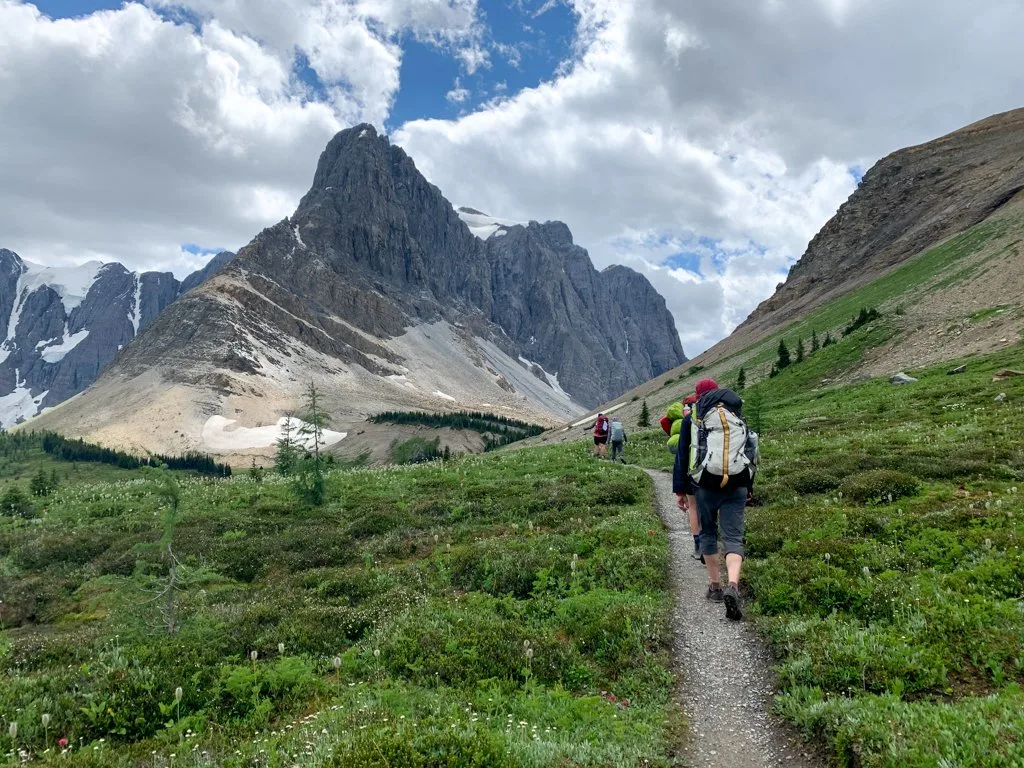If you aren’t used to backpacking in the Canadian Rockies, it can be tough to figure out what to pack for the Rockwall Trail. It’s a high elevation route that crosses lots of windy, treeless mountain passes. But the camps are deep in shady valley bottoms. I hiked it in mid-August last year and came up with this Rockwall Trail packing list.
We had a bit of rain, some chilly nights, some sunny (but windy) days, and a few buggy campsites. I was happy with the gear that I brought since it wasn’t too heavy or bulky but still kept me comfortable. Read on for all the details of what to bring on the Rockwall Trail in Canada’s Kootenay National Park.
READ NEXT: Rockwall Trail Guide: Everything You Need to Know
Hey there: Some of the links in this post are affiliate links, which means I earn a small commission at no cost to you. Thanks for your support. -Taryn
Rockwall Trail Essentials
Backcountry Camping Permit
Print out a copy of your backpacking camping permit and store it in a Ziploc bag. Rangers may ask to see it while you are on the trail. For more information on how to get Rockwall Trail permits and how much they cost, see my Rockwall Trail Guide.
National Parks Pass
You need a National Parks pass to hike the Rockwall Trail. You can buy one at entrance kiosks to the mountain National Parks, or bring your annual pass if you already have one. Leave it on your dashboard while you are hiking to avoid a ticket.
Rockwall Trail Map
Hiking the Rockwall Trail is straightforward, with signs at all junctions. For most hikers, the basic Kootenay National Park hiking map from Parks Canada is all you’ll need. The Kootenay National Park map from Gem Trek is what I used. It’s a topographic map with all the trails and campgrounds. I found it really helpful to visualize the terrain (and elevation gain) for each day.
Guidebook (Optional)
I didn’t bring a guidebook on the Rockwall Trail, but I did read a few before I left. The best one is Don’t Waste Your Time in the Canadian Rockies, which has a long section on the Rockwall Trail. Instead of bringing the whole book, I took photos of the most relevant pages on my phone, then looked at them on the trail.
GPS (Optional)
We used the Gaia GPS app on our phones and our Garmin GPS watches on the Rockwall Trail. It was nice to know how many kilometres we had walked and to be able to gauge how far it was to the next landmark. (Psst! Want to save 20% on a Gaia GPS annual membership, which gets you the same maps I used on the Rockwall Trail? Use this link.)
I have a Garmin vivoactive 3 GPS watch that keeps track of my distance, heart rate, etc. I swapped out the plain black band for this fun (and cheap!) blue one. My husband has a Garmin Fenix 6 that you can load maps onto, which is MUCH more helpful for hiking.
Have questions about what to bring on the Rockwall Trail? Join the Rockwall Trail Planning Facebook Group to get advice from other hikers!
Backpacks and Bags
Backpack
When looking for a backpack, choose something between 60 and 75L. Do a test pack at home to make sure you can get all your gear inside. Make sure you pick a backpack that fits you well and is comfortable to carry.
I used my new Gregory Amber 65 on the Rockwall Trail. lt was my first long trip with that pack and it was really comfortable, even under a heavy food load on the first couple of days. My husband and a friend both have the men’s version, called the Gregory Stout.
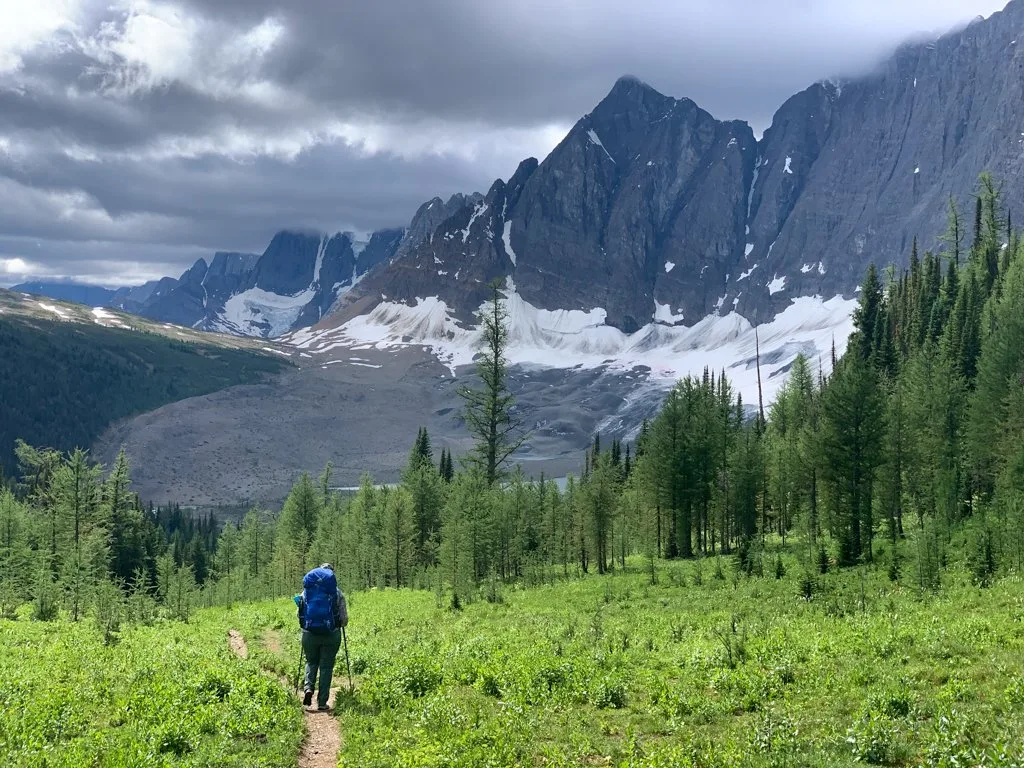
Stuff Sacks and Organizers
To stay organized I like to pack my gear in a combination of different sized stuff sacks. Mostly I use lightweight dry bags. It can rain out of nowhere in the Canadian Rockies, so keeping your gear dry is really important. I like the Sea to Summit Ultra-Sil window dry bags. They’re waterproof but still incredibly lightweight. Plus they have a clear panel so you can see what’s inside.
Rain Protection
If your gear gets wet, it can really ruin your trip. Thankfully, on my trip, we had hardly any rain. I brought a rain cover for my backpack. Some packs come with a custom-sized rain cover. If yours didn’t, buy a lightweight silnylon one that fits your pack well.
Pro tip: If you tend to overstuff your pack or attach things to the outside, buy a slightly larger-sized rain cover.
I also lined the inside of my pack with a trash compactor bag. They are HUGE plastic garbage bags that are much more durable than a standard garbage bag since they are designed to go inside a kitchen trash compactor. Some hikers report that they can use the same one for several years before it develops holes. They are hard to find in Canada so it’s easiest to order them online.
Tent and Sleeping Gear
Tent
Since it is high in the Canadian Rocky Mountains, the Rockwall Trail can see some seriously bad weather and heavy rain. You need a proper backpacking tent that is lightweight, compact, and has a full-length waterproof rain fly. This isn’t the place for a cheap, big-box store tent that will leak.
We actually brought our ultralight Zpacks Triplex on the Rockwall Trail. It’s a single wall tent, so we did have a bit of condensation inside, but for me, the weight savings were worth it.
The Triplex is a niche, ultralight tent, so if you’re looking for something more mainstream, I recommend the MSR Hubba Hubba NX. I’ve been using one for over a decade and I can’t say enough good things about it. (Well except that it isn’t cheap!) If the Hubba Hubba isn’t in your budget, check out the MSR Elixir.
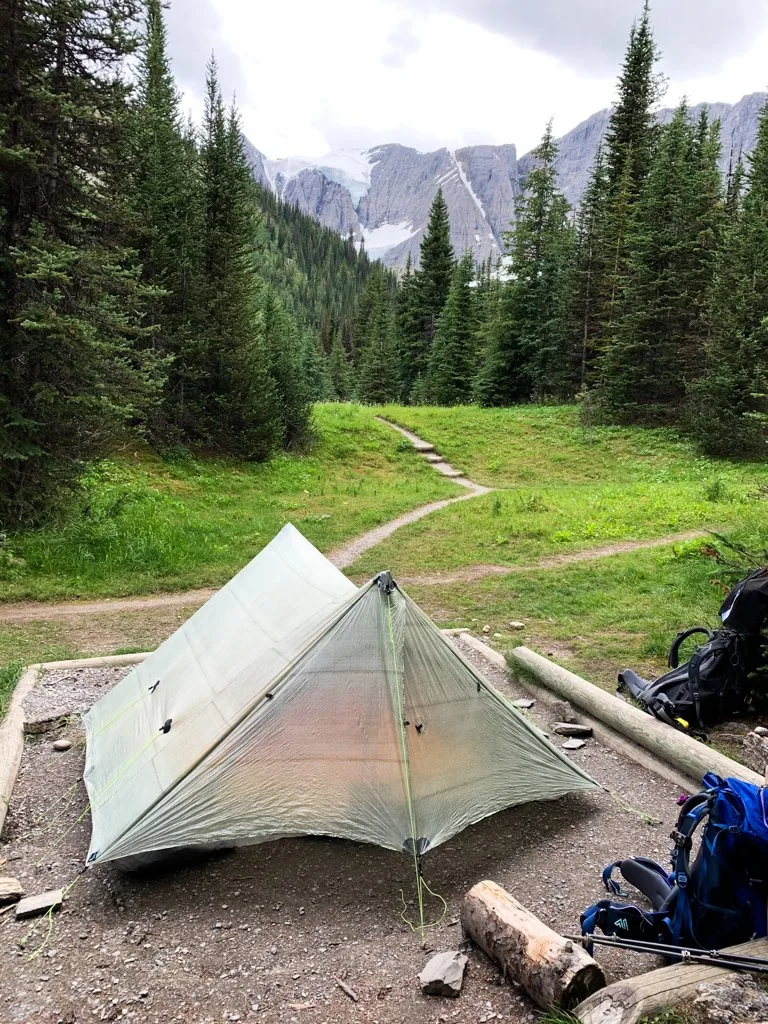
Tarp and Cord (Optional)
You’ll be lucky if you can hike the entire Rockwall Trail without being rained on. It’s a good idea to add a lightweight silnylon tarp to your Rockwall Trail packing list, especially if you are in a group. It’s great for cooking and hanging out under at camp. It also doubles as a great sunshade if you are lucky enough to need one.
We brought an 8’x10′ silnylon tarp that was big enough to fit our entire group of 8. You’ll also want to bring lots of cord and some extra pegs to help set it up.
Sleeping Bag and Compression Sack
The weather on the Rockwall Trail can all over the place. It can be sunny and high twenties but then plunge close to freezing with rain and wind (especially at night). I recommend packing a lightweight and compressible sleeping bag rated at least 0C, but -7C is a bit safer.
I brought my Therm-a-rest Oberon -18C bag (an older version of the Therm-a-rest Parsec -18C). It was waaay overkill, but since it is super light (only 1kg) it made sense.
If you’re looking for a more affordable option, the MEC Draco -9C is great and still relatively light. (It also comes in a women’s version called the Delphinus. (What’s the deal with women’s sleeping bags? Read my post when women’s specific gear is worth it to find out.)
Make sure you pack your sleeping bag inside a compression sack so it takes up less space in your pack. I like the Outdoor Research Ultralight Compression sacks since they come in lots of sizes.
Sleeping Pad
The warmest sleeping bag can’t protect you from the cold, hard ground. You’ll need a sleeping pad for that. Choose one that is compact, lightweight, and has an R-value of at least 2.5. (R-value measures insulation and warmth).
If you expect cold weather or know you feel the cold at night, pick a pad with an even higher R-value. I use a Therm-a-rest NeoAir Xtherm since I sleep really cold. (Although it was probably overkill for the Rockwall Trail.) My husband likes his NeoAir XLite which weighs less but isn’t quite as warm.
Pillow (Optional)
You can use a bunched-up jacket as a pillow, but I recommend adding a compact camping pillow to your Rockwall Trail packing list. Your neck will thank you. I use a simple MEC inflatable pillow.
Ear Plugs (Optional)
Some of the campsites on the Rockwall Trail are very close together, which means your tent will be a few feet from your snoring neighbours. And while you might be on an early morning schedule, inevitably the people next door will be night owls.
If you’re a light sleeper, I recommend bringing a few pairs of foam ear plugs. You’re bound to lose some so it’s good to have extras. I like the contoured ones since I find they fit in my ears better.
READ NEXT: How to Stay Warm in a Tent: Over 40 Tips
Clothing
Rain jacket
I can’t imagine doing the Rockwall Trail without a good rain jacket. Much of the trail is high in the mountains above the treeline, where there is no shelter from the rain. Add a waterproof breathable rain jacket designed for hiking to your Rockwall Trail packing list – preferably one with pit zips for venting. (They will keep you from overheating when you’re hiking uphill).
I didn’t get much rain on my Rockwall Trail hike, but we did get a bit. I brought my MEC Flash Cloud Gore-Tex jacket. It’s incredibly light so it didn’t take up much space in my pack on the days I didn’t wear it. If you want something less expensive but still very lightweight, the Outdoor Research Helium II is a great option.
Rain Pants
Pack a pair of waterproof breathable rain pants that you can easily layer over top of your hiking pants. I didn’t need to use mine when I hiked the Rockwall Trail, but I’ve definitely been glad to have them on cold and wet days on other mountain trips. Ones with side zippers for venting are easy to put on and take off without removing your shoes. I have the MEC Hydrofoil Stretch Rain Pants.
Wind Jacket (Optional)
I love bringing a superlight wind jacket on mountain hikes. It’s perfect to throw on over a t-shirt when I want to block the wind but don’t need much additional warmth. I have a Patagonia Houdini Jacket that packs down smaller than my fist.
Fleece Jacket or Light Weight Puffy Jacket
After dark or when the wind picks up, it can get a little cold on the Rockwall Trail. Pack a fleece jacket or a lightweight puffy jacket that you can layer on over a t-shirt and under your rain jacket. I brought my MEC Rockwall fleece jacket and wore it every night in camp. (It’s called the Rockwall – I pretty much had to bring it!)
I also brought a lightweight puffy jacket for even more warmth. I have an older version of the MEC Airstream Hoodie. My husband brought his Patagonia Nano Puff Jacket.
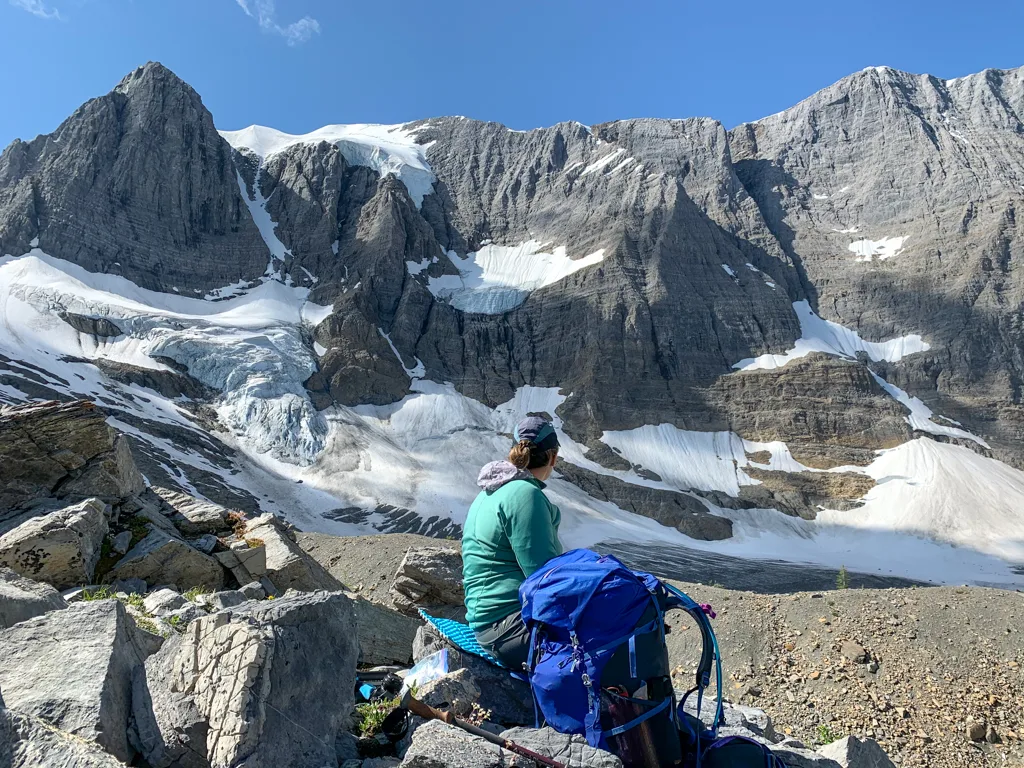
Hiking pants or tights (1 pair)
Choose quick-drying hiking pants made of nylon or polyester (and maybe with a bit of spandex for stretch). Many women prefer to hike in tights or leggings and since the Rockwall doesn’t have any scrambling or much brush, they would work well here.
I love my MEC Terrena Stretch pants and brought them on the Rockwall Trail. I also like the Prana Halle Pants. If you like pants that convert into shorts, the Halles come in a convertible version. The men’s version of the Prana Halle is the Stretch Zion pants.
Shorts (1 pair) (Optional)
On some days in late July and August, the weather on the Rockwall Trail is warm enough for shorts. However, some people prefer to hike the Rockwall Trail in pants no matter the season to protect from rain, bugs, and scratches. I’m a shorts person and wore shorts most days. The MEC Terrena Stretch Shorts 12″ are my favourite hiking shorts. They’re really lightweight, stretchy, and dry quickly. They also come in a men’s version called the Mochilero shorts. (My husband owns 4 pairs!)
Shirts (2)
I usually hike in quick-drying workout t-shirts. On the Rockwall Trail, I brought one short-sleeved t-shirt and one long-sleeved button-up shirt. Mostly I wore the short-sleeved shirt, but the long-sleeved shirt was great for sun protection on the hotter days with no shade.
I love the Patagonia Capilene Cool Trail t-shirt since it looks like a regular t-shirt but wicks sweat and resists odours. But any old quick-dry polyester workout t-shirt will do. For a long-sleeved shirt, I brought an old button-up hiking shirt that is lightweight and has UPF protection. The North Face First Trail UPF Shirt is similar.
Sleeping and Camp Clothes
When you get to camp, you’ll want to take off your sweaty hiking clothes and put on something a little fresher. You’ll also want something warm and dry to sleep in. I brought some lightweight long underwear. (Although, mostly I wore my fleece and hiking pants around camp, then changed into thermals just to sleep.)
For bottoms, I brought Smartwool merino wool long johns that can pass as tights so I can wear them around camp. I also brought a discontinued MEC thermal top. My husband likes Patagonia’s Capilene Midweight long underwear – they are similar to my discontinued MEC ones.
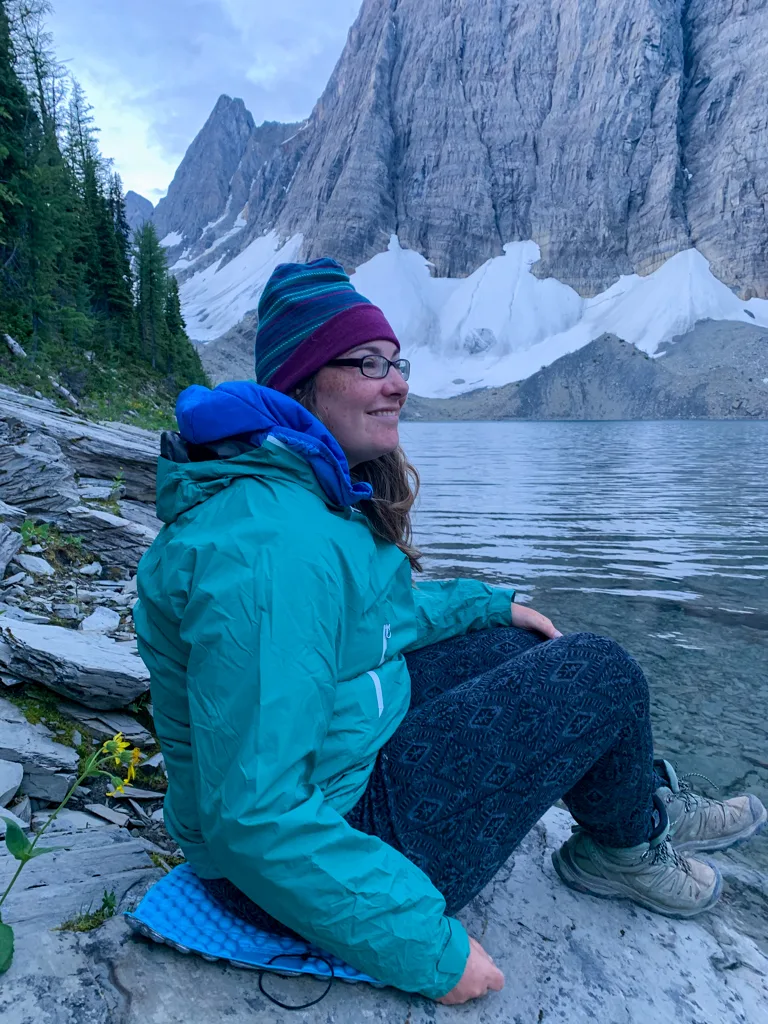
Underwear (3 pairs)
I like to bring two kinds of underwear on long backpacking trips: two or three pairs of quick-drying synthetic underwear for hiking and one pair of comfortable cotton underwear for wearing at night. You don’t need a fresh pair for every day. Let them air out at camp for an afternoon or two or rinse them in a stream, then wear them again.
Seamless underwear will be way more comfortable for hiking since they prevent chafing. I love Patagonia’s Active seamless underwear.
Many of the guys I hike with swear by boxer briefs like the ones from Saxx with a built-in pouch to prevent their package from rubbing the inner thighs.
READ NEXT: Best Hiking Underwear For Women and Men: How to Choose
Sports Bra
You don’t need a ton of support for trekking, so try to choose a bra without a lot of fabric layers that will take a long time to dry. I really like the Knixwear bras for backpacking since they are super lightweight, don’t absorb too much moisture, and are seamless so they don’t chafe.
Toque or Buff
Bring a fleece or wool hat that covers your ears. Or bring a buff that you can wear as a hat, an ear warmer, or a neck gaiter. It can get chilly on the Rockwall Trail, especially at night or when it gets windy. I love my merino wool buff, which is cozy warm but still lightweight. I brought both a toque and buff and ended up wearing both to sleep on one chilly night.
Sun Hat and Sunglasses
The sun can be harsh on the Rockwall Trail because you are high up in the mountains with no shade Bring a wide-brimmed hat or baseball cap and a pair of sunglasses for protection. If you’re hiking south to north, you will have the sun at your back all day so you may want a hat that protects the back of your neck.
I like to wear polarized sunglasses as they cut the glare better. I love my Sunskis since they have fun frame options and they aren’t too expensive for polarized glasses.
Gloves (Optional)
Gloves are good to have for chilly nights or cold days on the trail. Simple fleece gloves are all you need for the Rockwall Trail. I only used mine at night.
Join the Rockwall Trail Facebook group
Footwear
Hiking Boots
The Rockwall Trails is not very technical – there is very little mud and hardly any rough terrain. That means that you don’t need heavy-duty boots. (Although if you aren’t used to carrying a heavy pack, boots with ankle support are a good idea.)
I wore Salomon X Ultra Mid GTX boots on the Rockwall Trail. They aren’t a full leather boot. Instead, they use a durable fabric outer and a waterproof breathable membrane. They are lightweight and not too stiff, so they didn’t feel heavy and clunky like leather boots can. They have mid-cut ankle support, which was enough for me. If you want more support, my husband wears a higher-cut version of my boots called the Salomon Quest GTX. He loves them.
Camp Shoes (Optional)
It’s nice not to wear your boots all day. Pack a lightweight pair of shoes or sandals for around camp. Pick ones that are light and don’t take up too much room in your pack. I brought a pair of flip flops that I wore with toe socks. A few people in my group had Crocs, which they loved.
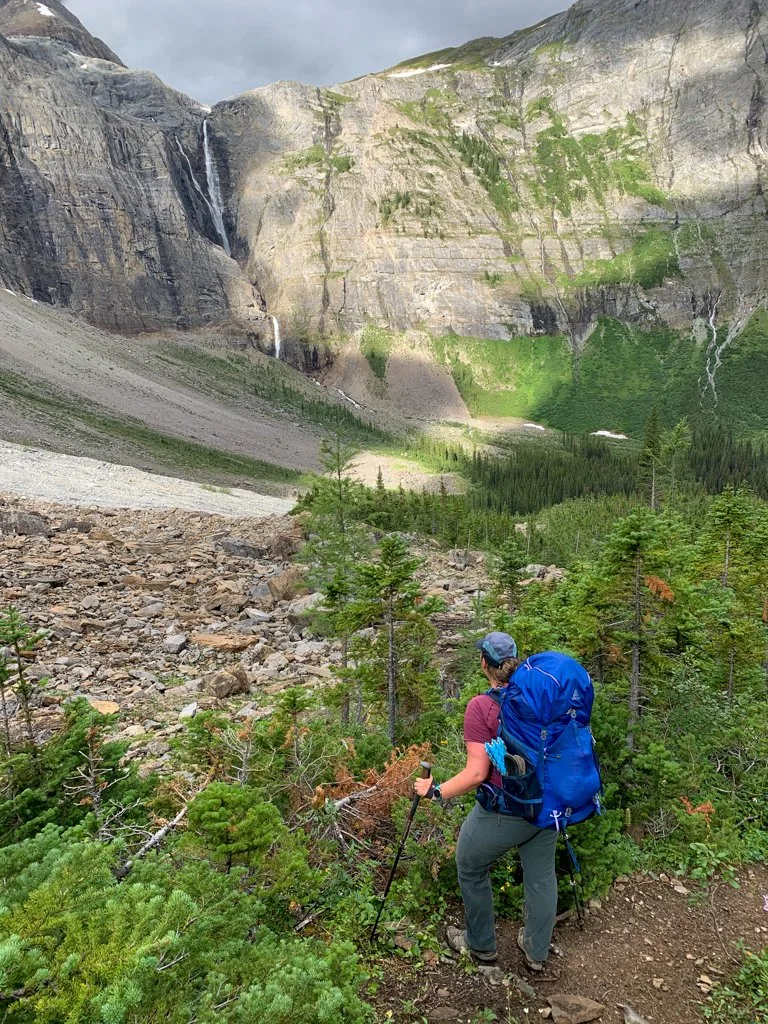
Socks (3 or 4 pairs)
Keeping your feet happy on the Rockwall Trail is super important. Pack 3 or 4 pairs of wool and synthetic blend socks that fit well. I also wear liner socks since they can help reduce the rubbing that can cause blisters. Try your socks and boots at home before your trek to make sure they don’t cause any problems. Air your socks out when you get to camp to keep them fresh.
In the last few years, I’ve converted to Smartwool socks. They’re comfortable and don’t make me overheat. I wear the Smartwool Performance Light socks. For liners, I love Injinji toe socks since they help prevent blisters between your toes.
Toiletries
Toothpaste and Toothbrush
I get travel-sized tubes of toothpaste from the dentist to take on hiking trips. I also use a Carry Clean toothbrush. It splits into two pieces, then you can nest the head inside the handle to keep it clean. AND it’s a lot shorter so it’s easier to fit into a smaller toiletry bag.
Deodorant, Baby Wipes, and Face Cloth
You’ll be getting sweaty every day. Bring a small travel-sized deodorant and some baby wipes for having a quick sponge bath at the end of the day. I also brought a small quick-dry face cloth. I got it wet in the creeks, then used it to give my face and stinky parts a quick wipe down.
Sunscreen and Lip Balm
Pack sunscreen and SPF lip balm to protect yourself from the sun. I brought a Sun Bum sunscreen stick. It was really easy to just swipe an extra layer of sunscreen on my nose and cheeks without getting it all over my hands.
Bug Spray and/or Head Net (Optional)
The bug situation on the Rockwall Trail depends on when you go. In July and early August, the mosquitos and black flies can be bad, especially in the campsites. We hiked in mid-August and they were non-existent in the mountain passes but a bit annoying in camp.
I didn’t use bug spray but some of my group did. I wore my head net a few nights in camp when we sat around chatting as it got dark. I would definitely recommend adding bug spray or a head net to your Rockwall Trail packing list.
Hair Brush and Hair Ties
If you’ve got long hair, you know why you need these.
Glasses, Contact Solution, and Spare Lenses
If you wear contacts, be sure to pack contact solution and extra lenses.
Toilet Paper and Hand Sanitizer
There are outhouses at every campsite, but toilet paper isn’t supplied. Put toilet paper on your Rockwall Trail packing list. Put it inside a Ziploc bag to keep it dry. Carry a small bottle of hand sanitizer to clean your hands after you use the toilet and before you eat.
Join the Backpacking in BC Facebook Group
First Aid and Safety
First Aid Kit
You should pack a small first aid kit. Make sure it includes bandages, gauze, medical tape, and a compression bandage for sprains. You’ll also want to have lots of foot care supplies such as Moleskin or Second Skin for blisters. (Check out my full list of blister care and prevention tips and tricks.) Bring anti-inflammatory painkillers, and anti-diarrhea pills just in case. And of course, don’t forget your usual prescription medications.
I like the Adventure Medical Ultralight first aid kits since they come in a water-resistant pouch. I always add more stuff to them, like more blister care and bandaids
Your first aid kit should also contain stuff to help repair your gear in case you have any problems. We packed a small multi-tool and some gear repair tape.
Bear Spray
The Rockwall Trail is home to grizzly bears, black bears, wolves, and cougars. But you’re more likely to see tracks and poop than the animals themselves. (Surprisingly, we didn’t even see any bear poop, let alone bears on our Rockwall Trail hike.)
Carry bear spray and make lots of noise when hiking. Buy bear spray and a holster so you can attach it to your backpack or belt. I’ve got lots more tips for hiking and camping in bear country in this post.
Satellite Communication Device
We bring our Garmin inReach Mini on every backpacking trip. It’s a satellite communication device that let’s us call for search and rescue or medical help with the push of a button. Our family at home can also watch our progress on a map, which they love. We also sometimes use it to text family members or emergency contacts if our plans change.
It’s expensive and requires an annual subscription, but we think it’s worth it for the additional peace of mind it provides. If you’re concerned about safety, a satellite communication device should be on your Rockwall Trail packing list.
Electronics
Camera
Of course, you can bring your phone to use as a camera, but you may want to bring a stand-alone camera. I brought my Sony A6000. It’s a mirrorless camera that is more compact than a full DSLR but still produces high-quality images. It’s easy to use, plus it’s not that expensive. I use a Peak Design Capture clip to carry it on the shoulder strap of my pack so it’s easy to grab. I also brought my GoPro Hero 7 Black to shoot some fun video footage on the trip.
Headlamp
Bring a headlamp to find your way around after dark. I brought the Petzl Bindi. It’s TINY yet still quite bright. Plus it’s USB rechargeable, which is so much more convenient than buying AA batteries.
Power Bank/Portable Charger (Optional)
If you’re bringing electronics, you’ll need a way to keep them all charged. Some people like solar chargers, but with the unpredictable weather on the Rockwall, a power bank is more reliable. Bring a power bank that has enough storage to charge your devices at least once, but isn’t too big and heavy. The size you choose will depend on how many devices you bring, but at least 2,500mAh capacity or larger is probably a good idea.
Cooking Gear
Stove, Fuel, and Lighter
Fires aren’t allowed at most campsites on the Rockwall Trail. Plan to cook on a lightweight and compact backpacking stove. And don’t forget a lighter! Our friends brought their tiny Pocket Rocket Deluxe stove, which uses disposable fuel canisters. We have one too, but we opted to bring our Primus Omnifuel stove on the Rockwall. Since it was a longer trip, we wanted to bring a white gas stove so we could carry the exact amount of fuel we needed and not have to pack out empty canisters.
Cooking Pot
Choose lightweight camping pots. Unless you are making elaborate meals, you probably just need one pot. We use a Primus Primetech pot that has a built-in heat exchanger that optimizes fuel consumption and protects the flame from the wind.
Bowl & Mug
I like the Sea to Summit X Bowls since they are collapsible and I can store them inside my cooking pot. You’ll want hot drinks to warm you up on cold evenings. I recently upgraded to a swanky Snow Peak Titanium double wall mug. It’s pricey, but it’s soooo light. Plus the double walls keep my morning tea toasty warm.
Knife and Utensils
Bring a sharp knife for cutting, plus a spoon and fork for eating. Or get a spork – they do double duty! I love my Snow Peak Titanium spork.
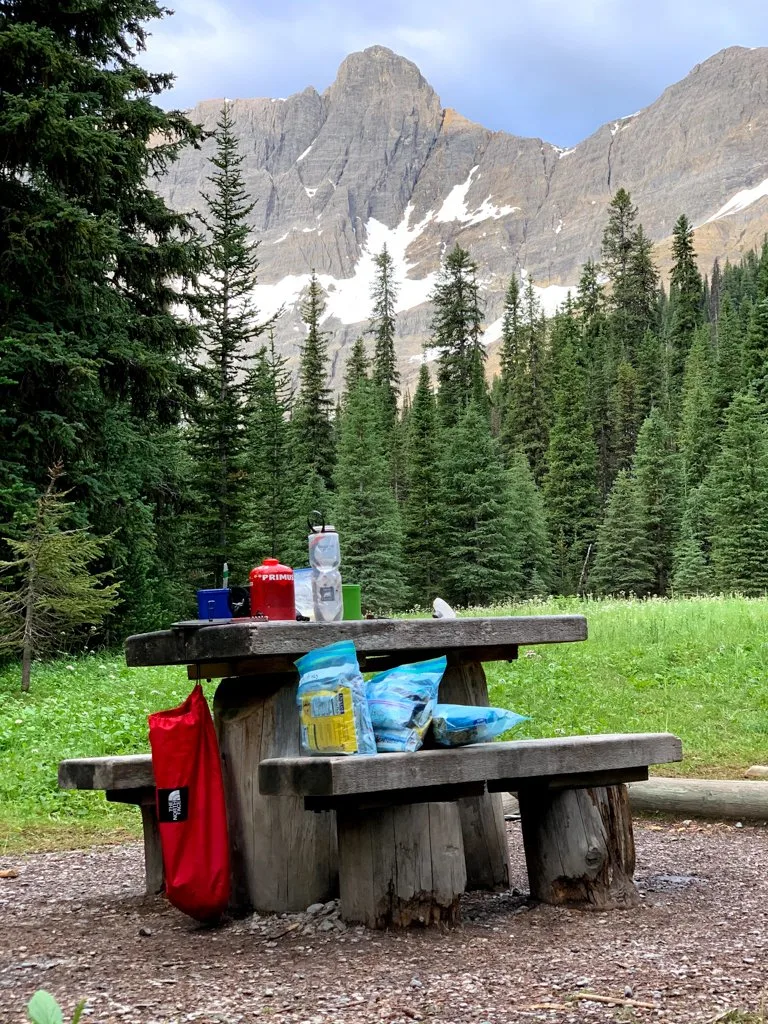
Dishwashing Supplies
We carry a small pot scraper, a tiny microfibre cloth, and some biodegradable soap. Use soap sparingly and be sure to pour your dishwater into a cat hole. Don’t put soapy water directly into streams since even biodegradable soap isn’t safe to go directly into the water. (Read more about how to Leave No Trace.)
The GSI compact scraper has a hard edge for scraping stuck-on stuff and a spatula-like edge for scraping softer stuff. We use Dr. Bronner’s for really greasy dishes and the rest of the time we skip soap and just use warm water and a scraper.
Food and Water
Water Treatment
You need to treat all the water you drink on the Rockwall Trail. The streams might look clean, but there could be animals and humans upstream who poop. We brought our Platypus Gravityworks filter. It is really easy to use since there’s no pumping or squeezing. You just hang it up and let it drip through.
Water Bottles or Hydration Reservoir
Bring a couple of water bottles or a hydration reservoir. On some stretches of trail, you’ll go a few hours without reaching a water source. I brought a Platypus Big Zip Evo 3L reservoir. Most days I just put 1 or 1.5L in it in the morning, then filtered more when we stopped for lunch.
Food
Bring lots of high-calorie food that is lightweight and compact. Don’t forget the snacks! You’ll burn more calories hiking than on a usual day so don’t be afraid to pack a little extra. Check out my tips for choosing the best backpacking meals and my guide to making cheap backpacking meals from grocery store ingredients.
Food Bag
To protect your food from bears and other critters, you need to store your food inside metal food lockers at each campground.
We used a lightweight dry bag to store our food. They are waterproof and the roll-top cuts down on odours, so animals will be less attracted to your food. We used two SealLine Bulkhead View dry bags. They have a purge valve to squeeze out excess air and the window makes it easier to figure out what’s inside.
Optional Extra Gear
Trekking Poles
The Rockwall Trail has a few steep ascents and descent where trekking poles can be helpful to save your knees. I bought trekking poles for my first West Coast Trail hike back in 2004 and have been a convert to them ever since. If you already use trekking poles, definitely consider taking them on the Rockwall Trail. I brought my Black Diamond Alpine Carbon Cork trekking poles and was really happy to have them.
Bathing Suit and Quick-Dry Towel
Although it’s icy cold, some people go for a brave swim in Floe Lake. Men can likely just wear their trekking shorts as a bathing suit. Women may want to bring a swimsuit just in case, but I usually swim in my sports bra and underwear. If you plan to swim, bring a quick-drying microfibre towel. I like the PackTowl microfibre towels since they dry fast. You can get away with a small one.
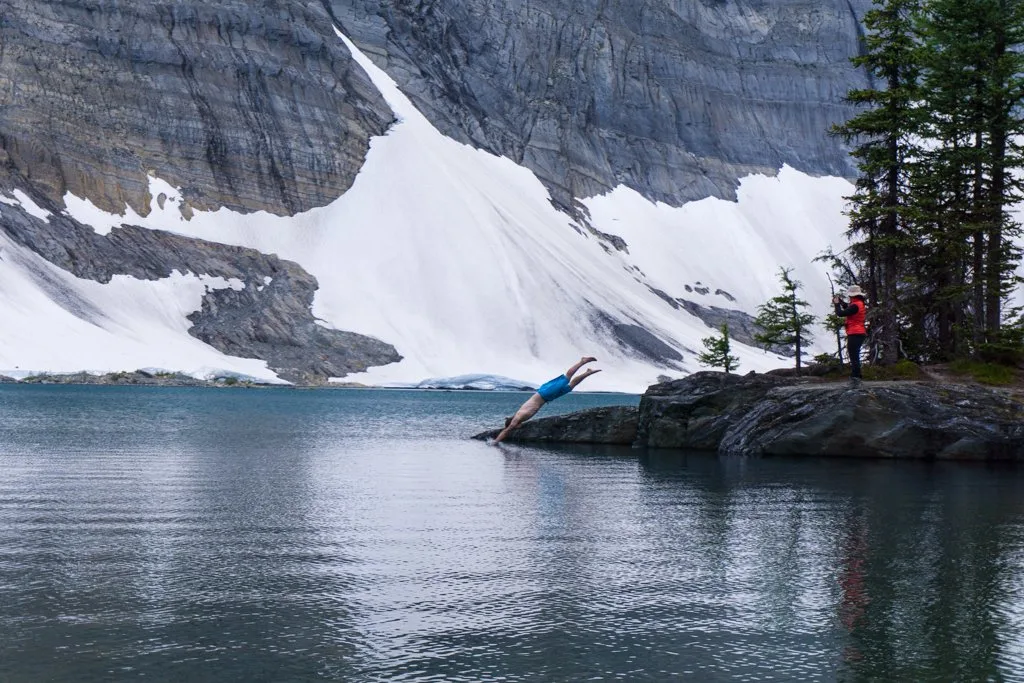
Entertainment for Camp
You’ll have a few hours each night in camp when you’ll need to entertain yourself. Consider bringing a book or some headphones to listen to music or podcasts. I always travel with my Amazon Kindle eReader so I have hundreds of books to choose from. We’ve brought the card game Exploding Kittens on a few backpacking trips and it’s always a hit.
Ultralight Chair or Seat
After a long day of hiking, you don’t always want to sit on the ground. My husband and I both have the ultralight Helinox Chair One. It collapses down really small and weighs about 1kg. (You can find cheaper knock-off versions on Amazon too!) My husband and a friend brought theirs on the Rockwall Trail but I opted to leave mine at home to save weight.
Instead, I brought a tiny folding Thermarest Z Seat foam bum pad. It was nice to have a dry place to sit at all times. And at only 60g, I saved a LOT of weight compared to a chair.
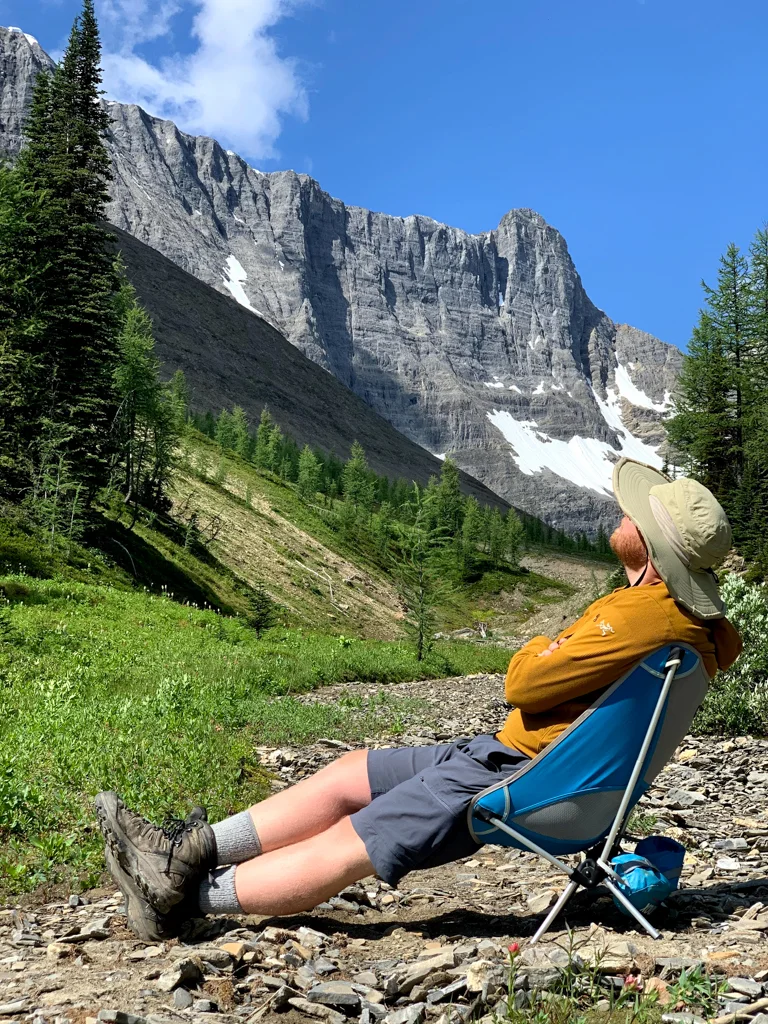
Stuff You Don’t Need to Pack for the Rockwall Trail
Here’s my list of stuff you don’t need and shouldn’t pack for the Rockwall Trail:
- Tons of outfit changes: Everyone else will be wearing the same stinky clothes over and over, so you can too. Plus it’s just too heavy to pack an outfit for every day.
- Portable speakers: Most people come to the Rockwall Trail to appreciate the sounds of nature and prefer not to hear your music. The campsites can also be really close together, so you’ll want to keep the noise down.
- A gun: They aren’t allowed on the Rockwall Trail.
- Drones: They aren’t allowed in any national park unless you have a special use permit.
Join the Rockwall Trail Facebook group
Have you hiked the Rockwall Trail? What piece of gear made the biggest difference? Which gear do you recommend other hikers add to their Rockwall Trail packing list? Tell us in the comments.
Have questions about what to bring on the Rockwall Trail? Join the Rockwall Trail Planning Facebook Group to get advice from other hikers!
More Bucket-List Worthy Canadian Hiking Trips:
- Rockwall Trail Guide: Everything You Need to Know
- The Ultimate Guide to Hiking the Berg Lake Trail
- Your Guide to Camping and Hiking at Lake O’Hara in Yoho National Park
- Your Guide to the West Coast Trail in British Columbia
- How to Take an Epic Canadian National Parks Road Trip
Must-Have Backpacking Advice:
- Backpacking Checklist: Gear You Need To Go Backpacking
- 20+ Ways to Reduce Your Backpack Weight
- Best Hiking Underwear For Women and Men
- How to Choose the Best Backpacking Meals
- Grocery Store Backpacking Meals for Cheap
- Bear Safety for Hikers, Campers and Backpackers
- How to Leave No Trace (And Why it’s Important!)
- Gear I Use (My personal gear list)
- How to Stay Warm in a Tent: Over 40 Tips
- My Favourite Hiking Gear of 2025 - December 9, 2025
- Best Insulated Skirts For Hiking and Snowshoeing in 2026 - December 5, 2025
- Snow-Free Hikes in Vancouver: 50+ Year-round Trails - December 4, 2025

